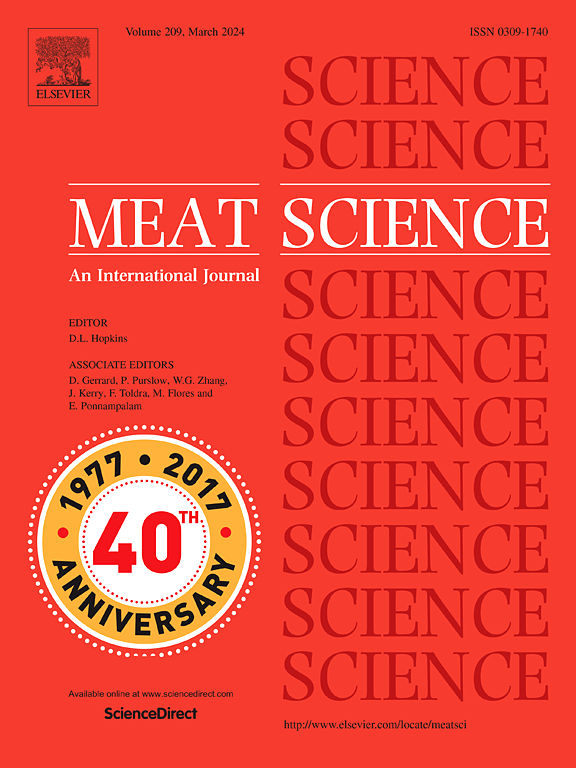Exploring the impact of barberry extract and grilling on oxidative and nitrosative reactions in fermented sausages: Insights into lipid-protein oxidation, nitrosamine, and 3-nitrotyrosine as a potential biomarker
IF 6.1
1区 农林科学
Q1 Agricultural and Biological Sciences
引用次数: 0
Abstract
This study examines the effect of barberry extract (BE) on the oxidative and nitrosative stability, as well as the quality, of meat batter, fermented sausages, and grilled sausages. Four groups were tested: Control (no BE), B200 (200 mg/kg BE), B300 (300 mg/kg BE), and B400 (400 mg/kg BE). BE exhibited high total phenolic content (46.33 mg GAE/g) and antioxidant activity (92.93 %), with a pH of 3.80. LC-QTOF-MS identified key compounds such as chlorogenic acid, quercetin, and canadine, known for their antioxidative properties. BE significantly reduced nitrite content, demonstrating pH-dependent nitrite-scavenging activity. Higher concentrations (B300, B400) led to reduced redness (a*), indicating slight changes in color stability. BE also inhibited lipid-protein oxidation, with lower peroxide values, TBARS, carbonyls, and sulfhydryls, and significantly reduced 3-nitrotyrosine (3-NT) and nitrosamine concentrations (P < 0.05). Despite cooking-induced increases in nitrosamines, BE minimized this rise, keeping nitrosamine levels lower than the control (P < 0.05). The correlation between 3-NT levels and oxidation products suggests 3-NT as a potential biomarker for oxidative stress. These findings suggest that BE enhances antioxidant properties, mitigates nitrosative stress, and improves the quality of meat products.

探索巴贝提取物和烧烤对发酵香肠中氧化和亚硝化反应的影响:脂质蛋白氧化、亚硝胺和3-硝基酪氨酸作为潜在生物标志物的见解
本研究考察了枸杞提取物(BE)对肉糊、发酵香肠和烤香肠的氧化和亚硝化稳定性以及质量的影响。试验分为4组:对照组(无BE)、B200 (200 mg/kg BE)、B300 (300 mg/kg BE)和B400 (400 mg/kg BE)。BE具有较高的总酚含量(46.33 mg GAE/g)和抗氧化活性(92.93%),pH为3.80。LC-QTOF-MS鉴定出绿原酸、槲皮素和加拿大嘌呤等具有抗氧化特性的关键化合物。BE显著降低亚硝酸盐含量,显示出ph依赖性的亚硝酸盐清除活性。较高的浓度(B300, B400)导致红度降低(a*),表明颜色稳定性略有变化。BE还能抑制脂质蛋白氧化,降低过氧化值、TBARS、羰基和巯基,并显著降低3-硝基酪氨酸(3-NT)和亚硝胺浓度(P <;0.05)。尽管烹饪引起亚硝胺的增加,BE将这种增加最小化,使亚硝胺水平低于对照组(P <;0.05)。3-NT水平与氧化产物之间的相关性表明3-NT是氧化应激的潜在生物标志物。这些发现表明,BE能提高肉制品的抗氧化性能,减轻亚硝化应激,改善肉制品的质量。
本文章由计算机程序翻译,如有差异,请以英文原文为准。
求助全文
约1分钟内获得全文
求助全文
来源期刊

Meat Science
工程技术-食品科技
CiteScore
12.60
自引率
9.90%
发文量
282
审稿时长
60 days
期刊介绍:
The aim of Meat Science is to serve as a suitable platform for the dissemination of interdisciplinary and international knowledge on all factors influencing the properties of meat. While the journal primarily focuses on the flesh of mammals, contributions related to poultry will be considered if they enhance the overall understanding of the relationship between muscle nature and meat quality post mortem. Additionally, papers on large birds (e.g., emus, ostriches) as well as wild-captured mammals and crocodiles will be welcomed.
 求助内容:
求助内容: 应助结果提醒方式:
应助结果提醒方式:


